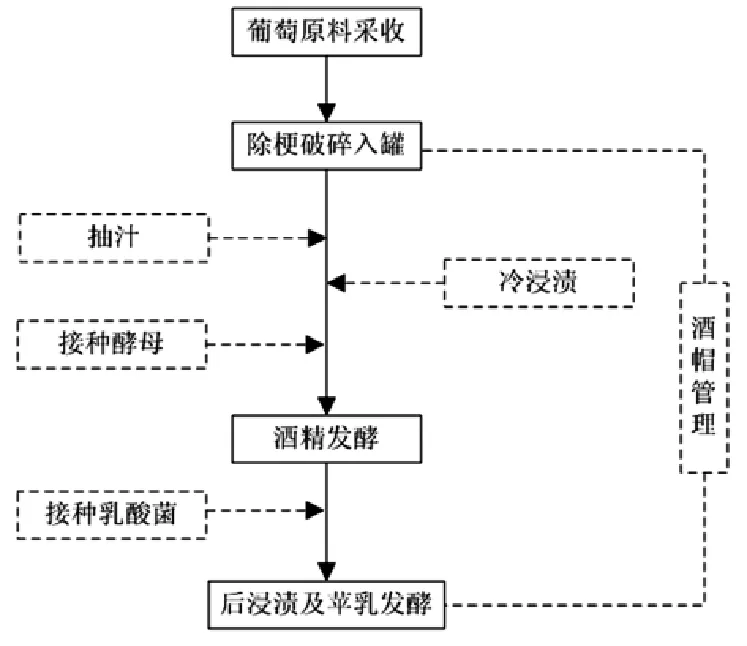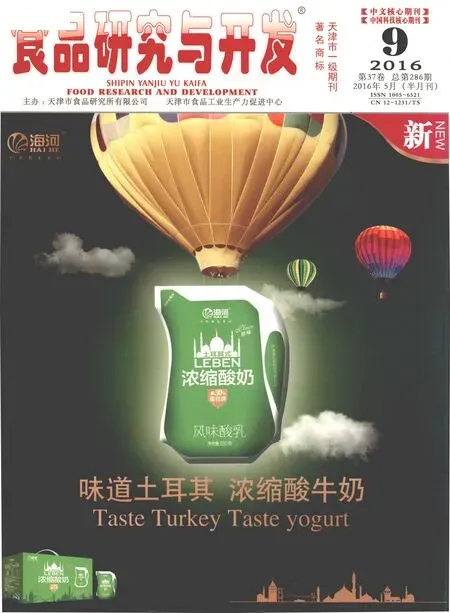酿造工艺对葡萄酒中生物胺的影响
2016-06-13刘沛通蔡花真吴广枫于可济中国农业大学食品科学与营养工程学院北京00083河南质量工程职业学院河南平顶山467000
刘沛通,蔡花真,吴广枫,*,于可济(.中国农业大学食品科学与营养工程学院,北京00083;.河南质量工程职业学院,河南平顶山467000)
酿造工艺对葡萄酒中生物胺的影响
刘沛通1,蔡花真2,吴广枫1,*,于可济1
(1.中国农业大学食品科学与营养工程学院,北京100083;2.河南质量工程职业学院,河南平顶山467000)
摘要:生物胺在葡萄酒等发酵食品中普遍存在,含量过高时对葡萄酒品质及安全性有不良作用。酒中生物胺的种类及含量取决于酿酒葡萄和酿酒工艺,综述了抽汁处理、浸渍处理、酒帽管理、酵母及乳酸菌等酿酒工艺对葡萄酒中生物胺的影响,对实际生产中葡萄酒的优质安全酿造提供一定的理论依据。
关键词:生物胺;葡萄酒;酿造工艺
1 葡萄与葡萄酒中的生物胺
生物胺(biogenic amines)是一类分子量较低的含氮化合物,在葡萄酒等发酵食品中普遍存在,由微生物对相应氨基酸的脱羧作用或氨基酸转氨酶对醛酮的转氨作用产生,部分生物胺也可由水果、蔬菜、鱼等非发酵食品内源性生成[1-2]。
葡萄果实和葡萄酒中均有生物胺的检出。大量研究表明葡萄果实中存在腐胺、亚精胺、尸胺、乙醇胺、组胺和羟色胺等多种生物胺,其中生物胺的种类和含量受品种、产地、年份、气候、土壤、栽培处理、品种及成熟度等因素影响[3-13]。
葡萄酒中也存在着多种生物胺,部分来自葡萄果实,部分由发酵产生。Soufleros、Manfroi等分别在酒精发酵阶段检测出组胺、酪胺、亚精胺的生成,研究发现酿酒酵母可显著提高酒中的生物胺含量[4,14]。更多学者认为葡萄酒中生物胺的主要来源是苹乳发酵。苹乳发酵过程中,葡萄酒中的生物胺前体氨基酸减少,组胺、腐胺等生物胺的含量显著升高[6,15-16]。苹乳发酵过程中生物胺主要由乳酸菌的脱羧作用产生,但也不排除其他微生物污染导致生物胺含量升高[6,17]。含酒脚的葡萄酒中生物胺含量较高,这是由于酒脚中的酵母发生自溶释放游离氨基酸和多肽,提高了生物胺前体物质的数量,继而被乳酸菌水解或脱羧生成生物胺[12]。发酵过程中的其他因素如酒的pH、二氧化硫添加量、澄清剂的使用以及木桶陈酿的时间等,都对葡萄酒中生物胺的种类及含量有一定影响[18-20]。发酵结束后的葡萄酒中存在多种生物胺,其中腐胺、酪胺、组胺是主要的生物胺[15-16,21-22]。
低含量的生物胺是生物体许多生理功能所必须的,但当人体对生物胺的摄入超过一定量时,会引发如恶心、呼吸困难等过敏性失调症状[1,23]。由于生物胺的生理功能和毒理学性质,其在食品中的存在构成了潜在的公共健康隐患,故对其控制就显得格外重要。FDA规定食品中的组胺不能超过500 mg/kg,而在酒精饮料中,各国对葡萄酒中组胺的规定范围如下:德国不超过2 mg/L,比利时不超过5 mg/L~6 mg/L,法国不超过8 mg/L,瑞士不超过10 mg/L[12,24-25]。
2 酿造工艺对葡萄酒中生物胺的影响
葡萄酒中的生物胺大部分是在发酵过程中产生的,不同的酿造工艺(图1)会影响葡萄酒中酚类物质、含氮化合物、多糖等物质的含量,继而对酒中生物胺的种类及含量造成影响,故选择合适的酿造工艺至关重要[12,26]。

图1 发酵工艺流程图Fig.1 Enological process of wine
2.1抽汁处理
抽汁处理(Juice Run-off,也称Saignée)是指在葡萄酒发酵前抽取一部分葡萄汁以增加皮汁比的工艺。由于葡萄酒中的花色苷、单宁及部分含氮化合物等物质多在皮籽中存在,故该工艺可以提高葡萄汁中这些物质的浸出率,增加其在成酒中的含量[26]。Zamora等研究了抽汁和葡萄酒中酚类物质含量的关系,通过对9个品种葡萄的检测分析,发现陈酿约4个月后葡萄酒中类黄酮和花色苷含量的规律为:10%抽汁>未抽汁>10%添汁[27]。抽汁增加“黑比诺”、“西拉”葡萄酒中的酚类物质含量[26,28]。有研究表明,酚类物质可抑制氨基酸脱羧酶的活性,从而减少葡萄酒中生物胺的生成[12,29-30]。Gawel等研究发现抽汁处理可改变葡萄汁中氨基酸的含量,进而影响葡萄酒中的生物胺含量[28]。
2.2浸渍处理
酿酒过程中葡萄皮的浸渍有利于葡萄中如酚类物质、氨基酸和多糖等成分的浸提。葡萄皮浸渍工艺广泛地应用于红酒生产中,其中包括冷浸渍(酒精发酵前的低温浸渍)、带皮发酵(普通浸渍)和酒精发酵结束之后的后浸渍。碳浸渍和热浸渍等也是常见的浸渍工艺。冷浸渍处理是指在酒精发酵前将葡萄汁在低温下(5℃~15℃)浸渍若干天(4 d~10 d),以提升葡萄汁中香气物质和酚类物质等的含量[31]。大量研究表明冷浸渍可减少葡萄酒的氧化水平,增加酒中多酚和花色苷的含量[32-33]。
酒中生物胺的含量主要取决于前体氨基酸的含量。通常情况下,游离氨基酸含量的增加会导致生物胺含量上升[10]。氨基酸在皮、肉和籽中的分布与葡萄园管理、风土和品种有关。有研究发现“赤霞珠”葡萄果实15%~23%的氨基酸在果皮中,约77%的氨基酸在果肉中,8.5%的氨基酸在果籽中[34]。葡萄果皮和果籽中存在较多氨基酸,因而延长葡萄汁及葡萄酒与果皮的接触可增加酒中氨基酸的含量。浸渍工艺的结果就是从葡萄皮和籽中浸出氨基酸,或通过蛋白质水解及乳酸菌蛋白酶对酵母菌体的分解释放出氨基酸。Guitert等研究发现浸渍工艺可显著提高“霞多丽”葡萄酒中丝氨酸、甘氨酸、组氨酸和丙氨酸的含量,并可通过这些氨基酸的含量判别葡萄酒是否进行过该工艺处理[35]。葡萄皮浸渍工艺与酒中生物胺含量之间的关系曾有不同的报道。Soleas等发现浸渍时间与生物胺含量之间没有联系,但其他学者发现浸渍过程对酒中的生物胺含量有重要影响,时间越长生物胺含量越高[36]。Martín-álvarez等认为葡萄中添加蛋白水解酶并不会增加酒中的生物胺含量,其他酿造工艺如热浸渍、诱导还原发酵等可使生物胺含量升高[37]。Smit等研究发现,酒精发酵前冷浸渍处理的葡萄酒中氨基酸和生物胺含量较高,但苹果酸-乳酸发酵结束的葡萄酒中生物胺含量最低,冷浸渍可抑制葡萄酒中生物胺的生成[12]。
2.3酒帽管理
带皮发酵中,二氧化碳生成导致葡萄固形物上升至发酵罐顶部形成酒帽。酒帽的形成会使发酵罐内部温度不均匀,酒帽附近温度升高,同时果皮和果籽与葡萄汁的接触变少,不利于发酵的进行,故发酵过程中要进行果皮和果汁之间的接触混合。常见的混合方式有两种:将果皮压到葡萄汁表面下,俗称“压帽”(punch-down);或者把葡萄汁泵到发酵罐顶部进行淋汁,俗称“淋帽”(pump-over)。Fischer等分析了不同酒帽管理对包括“黑比诺”在内的3个品种葡萄酒中酚类物质含量的影响,结果表明酒帽管理可增加葡萄酒中酚类物质的种类,压帽处理的葡萄酒中浸出量比淋帽更多[38]。Marais的研究表明压帽处理的葡萄酒中总酚含量高于淋帽处理[39-40]。酚类物质含量的增加可抑制葡萄酒中生物胺的产生。酒帽管理增加了葡萄汁与果皮之间的接触,提高了果皮中酚类物质、含氮化合物等的浸出量,进而影响葡萄酒中生物胺的生成。
2.4酵母的种类
在葡萄酒的发酵过程中,除了酿酒酵母Saccha romyces cerevisiae外,还有许多其他酵母生长繁殖。葡萄酒中的生物胺一部分是由酵母菌在酒精发酵过程中产生的,不同酵母菌种对葡萄酒中生物胺的含量有一定影响[41]。Martín-Álvarez等研究表明葡萄酒中的生物胺种类及含量与酵母的种类有关,酵母脱羧酶的活性很大程度上取决于菌种[37]。Manfroi等研究了“美乐”葡萄酒酒精发酵和苹果酸-乳酸发酵过程中生物胺的变化,结果表明酵母显著影响葡萄酒中亚精胺的含量,Saccharomyces cerevisiae酵母发酵的葡萄酒中亚精胺含量显著高于Saccharomyces bayanus发酵的葡萄酒,同时也检测到不同酵母发酵的葡萄酒的酒精度、总酸和挥发酸以及感官品质等方面有显著差异[14]。Caruso等研究发现Saccharomyces cerevisiae等5个不同种的50株酵母菌在葡萄酒发酵过程中都能产生甲胺和胍丁胺,大部分酵母菌产生生物胺的总量低于10 mg/L,酵母菌的选择对葡萄酒品质有重要影响,而生物胺的产生量即可作为选择酵母菌的标准之一[42]。
酒精发酵结束后,葡萄酒中存在大量酒脚,其中含有大量酵母菌体,如不及时从酒中分离,菌体会发生自溶释放大量氨基酸,其他微生物进行氨基酸脱羧作用会产生生物胺,这是酵母菌对葡萄酒中生物胺的另一方面影响[17]。Bauza等发现带酒脚进行苹果酸-乳酸发酵的葡萄酒中会有更高含量的酪胺和腐胺生成[7]。
2.5乳酸菌的添加
乳酸菌(Lactic acid bacteria,LAB)是一类能利用可发酵糖产生乳酸的细菌,存在于葡萄汁和葡萄酒中,主要属于乳杆菌科(Lactobacillaceae)和链球菌科(Streptococcaceae)的4个属[43]。乳酸菌的主要作用是在酒精发酵结束后,将葡萄酒中的苹果酸分解为乳酸和二氧化碳,达到葡萄酒降酸的目的。苹果酸-乳酸发酵中产生的生物胺,主要由乳酸菌通过氨基酸脱羧酶对葡萄酒中的氨基酸脱羧产生[25,44]。Manfroi等研究了分别用Lactobacillus plantarum、Oenococcus oeni进行苹果酸-乳酸发酵和自然启动苹乳发酵的酒样,发现乳酸菌的种类显著影响苹乳发酵中羟色胺含量及生物胺总量,用L. plantarum发酵的酒样中羟色胺显著高于其他样品[14]。与此不同的是,Martín-álvarez等研究发现相较自然启动苹乳发酵,接种乳酸菌启动苹乳发酵可降低葡萄酒中的生物胺含量,可能是因为接种的乳酸菌抑制了葡萄酒中自带乳酸菌的繁殖,或是降低了其他杂菌的生物胺生成量[37]。Polo等研究发现乳酸菌类型是影响葡萄酒中生物胺含量的主要因素,使用商业菌株启动苹乳发酵可减少生物胺的产生,但并不能抑制野生细菌的繁殖增长[45]。Garciía-Ruiz等合成生物相容性的银纳米离子,以控制葡萄酒中的乳酸菌,减少其生物胺的产生[46]。近期研究表明,部分乳酸菌含有胺降解酶,可降解组胺、酪胺、腐胺等生物胺[29,47]。筛选低产生物胺甚至可降解生物胺的乳酸菌,对于葡萄酒的安全酿造具有重要意义。
2.6其他影响因素
葡萄酒中生物胺的种类和含量还受发酵温度、浸渍时间、二氧化硫添加量、pH、酒精度、溶氧量等的影响。其中二氧化硫含量、pH、酒精度和溶氧量等可通过调控乳酸菌的生长繁殖来影响葡萄酒中的生物胺。发酵温度一方面调控乳酸菌的生长,另一方面影响葡萄酒中含氮化合物的浸出量。葡萄酒在陈酿和瓶储过程中也会产生生物胺。Landete等在瓶储6个月的葡萄酒中检测到组胺含量有所上升,这可能是葡萄酒带酒脚储藏造成的[25]。
3 葡萄酒中生物胺的控制
葡萄酒中生物胺主要来源于发酵过程,选择适当的酿造工艺对于保证葡萄酒的安全性十分重要。影响生物胺含量的因素主要是前体氨基酸及酿酒微生物,在酿酒过程中可通过控制影响葡萄酒中前体氨基酸的抽汁处理、浸渍、酒帽管理,以及葡萄酒发酵过程中主要的微生物酿酒酵母及乳酸菌来调控葡萄酒中的生物胺含量及种类。同时,抽汁、浸渍等工艺还可对葡萄酒中的酚类物质含量产生影响,进而影响葡萄酒中生物胺的生成。实际生产中,选择品质优良、卫生状况好的葡萄原料,辅之以适当的酿造工艺,可减少葡萄酒中生物胺的产生。
参考文献:
[1]Zhijun L,Yongning W,Gong Z,et al. A survey of biogenic amines in Chinese red wines[J]. Food Chemistry,2007,105(4):1530-1535
[2]Önal A. A review:Current analytical methods for the determination of biogenic amines in foods[J]. Food Chemistry,2007,103:1475-1486
[3]Beneduce L,Romano A,Capozzi V,et al. Biogenic amine in wines [J]. Annals of microbiology,2010,60(4):573-578
[4]Soufleros E H,Bouloumpasi E,Zotou A,et al. Determination of biogenic amines in Greek wines by HPLC and ultraviolet detection after dansylation and examination of factors affecting their presence and concentration[J]. Food Chemistry,2007,101(2):704-716
[5]Smit I,Pfliehinger M,Binner A,et al. Nitrogen fertilisation increases biogenic amines and amino acid concentrations in Vitis vinifera var. Riesling musts and wines[J]. Journal of the science of food and agriculture,2014,94(10):2064-2072
[6]Del Prete V,Costantini A,Cecchini F,et al. Occurrence of biogenic amines in wine:The role of grapes[J]. Food Chemistry,2009,112(2):474-481
[7]Bauza T,Kelly M T,Blaise A. Study of polyamines and their precursor amino acids in Grenache noir and Syrah grapes and wine of the Rhone Valley[J]. Food Chemistry,2007,105:405-413
[8]Bover-Cid S,Iquierdo-Pulido M,Mariné-Font A,et al. Biogenic mono-,di- and polyamine contents in Spanish wines and influence of a limited irrigation[J]. Food Chemistry,2006,96(1):43-47
[9]Košmerl T,Šuc ur S,Prosen H. Biogenic amines in red wine- The impact of technological processing of grape and wine[J]. Acta agriculturae Slovenica,2013,101(2):249-261
[10]Herbert P,Cabrita M J,Ratola N,et al. Free amino acids and biogenic amines in wines and musts from the Alentejo region:Evolution of amines during alcoholic fermentation and relationship with variety,sub-region and vintage[J]. Journal of Food Engineering,2005,66(3):315-322
[11]Cecchini F,Morassut M. Effect of grape storage time on biogenic amines content in must[J]. Food Chemistry,2010,123(2):263-268
[12]Smit A Y,du Toit W J,Stander M,et al. Evaluating the influence of maceration practices on biogenic amine formation in wine[J]. LWT-Food Science and Technology,2013,53(1):297-307
[13]孔维府,范春艳,张翛翰,等.论葡萄酒中生物胺生成的影响因素及其检测方法[J].中国酿造,2010(6):13-16
[14]Manfroi L,Silva P H A,Rizzon L A,et al. Influence of alcoholic and malolactic starter cultures on bioactive amines in Merlot wines[J]. Food Chemistry,2009,116(1):208-213
[15]García-Marino M,Trigueros Á,Escribano-Bailón T. Influence of oenological practices on the formation of biogenic amines in quality red wines[J]. Journal of Food Composition and Analysis,2010,23 (5):455-462
[16]Izquierdo Cañas P M,García Romero E,Gómez Alonso S,et al. Amino acids and biogenic amines during spontaneous malolactic fermentation in Tempranillo red wines[J]. Journal of Food Composition and Analysis,2008,21(8):731-735
[17]Lonvaud-Funel A. Biogenic amines in wines:role of lactic acid bacteria[J]. FEMS Microbiology Letters,2001,199(1):9-13
[18]Martuscelli M,Arfelli G,Manetta A C,et al. Biogenic amines content as a measure of the quality of wines of Abruzzo(Italy)[J]. Food chemistry,2013,140(3):590-597
[19]Alcaide-Hidalgo J M,Moreno-Arribas M V,MartiN-Alvarez P J,et al. Influence of malolactic fermentation,post fermentative treatments and ageing with lees on nitrogen compounds of red wines[J]. Food Chemistry,2007,103(2):572-581
[20]Marques A P,Leitão M C,Romão M V S. Biogenic amines in wines-Influence of oenological factors[J]. Food Chemistry,2008,107(2):853-860
[21]Proestos C,Loukatos P,Komaitis M. Determination of biogenic amines in wines by HPLC with precolumn dansylation and fluorimetric detection[J]. Food Chemistry,2008,106(3):1218-1224
[22]Henríquez-Aedo K,Vega M,Prieto-Rodríguez S,et al. Evaluation of biogenic amines content in chilean reserve varietal wines[J]. Food and Chemical Toxicology,2012,50(8):2742-2750
[23]Zhai H,Yang X,Li L,et al. Biogenic amines in commercial fish and fish products sold in southern China[J]. Food Control,2012,25(1):303-308
[24]Tang T,Qian K,Shi T,et al. Monitoring the contents of biogenic amines in sufu by HPLC with SPE and pre-column derivatization[J]. Food Control,2011,22(8):1203-1208
[25]Landete J M,Ferrer S,Polo L,et al. Biogenic amines in wines from three spanish regions[J]. Journal of Agricultural and Food Chemistry,2005,53(4):1119-1124
[26]Sacchi K L,Bisson L F,Adams D O. A review of the effect of winemaking techniques on phenolic extraction in red wines[J]. American Journal of Enology and Viticulture,2005,56(3):197-206
[27]Zamora F,Luengo G,Margalef P. Effect of drawing off on colour and phenolic compounds composition of red wine[J]. Revista española de ciencia y tecnología de alimentos,1994,34(6):663-671
[28]Gawel R,Iland P G,Leske P A,et al. Compositional and sensory differences in Syrah wines following juice runoff prior to fermentation [J]. Journal of Wine Research,2001,12(1):5-18
[29]Callejón S,Sendra R,Ferrer S,et al. Identification of a novel enzymatic activity from lactic acid bacteria able to degrade biogenic amines in wine[J]. Applied microbiology and biotechnology,2014,98(1):185-198
[30]Kushnereva E V. Formation of biogenic amines in wine production [J]. Applied Biochemistry and Microbiology,2015,51(1):108-112
[31]Cai J,Zhu B,Wang Y,et al. Influence of pre-fermentation cold maceration treatment on aroma compounds of Cabernet Sauvignon wines fermentedin different industrial scale fermenters[J]. Food Chemistry,2014,154:217-229
[32]Ortega-Heras M,Pérez-Magariño S,González-Sanjosé M L. Comparative study of the use of maceration enzymes and cold pre-fermentative maceration on phenolic and anthocyanic composition and colour of a Mencía red wine[J]. LWT-Food Science and Technology,2012,48(1):1-8
[33]De Santis D,Frangipane M T. Effect of prefermentation cold maceration on the aroma and phenolic profiles of a Merlot red wine[J]. I-talian Journal of Food Science,2010,22(1):47-53
[34]Stines A P,Grubb J,Gockowiak H,et al. Proline and arginine accumulation in developing berries of Vitis vinifera L in Australian vineyards:Influence of vine cultivar,berry maturity and tissue type[J]. Australian Journal of Grape and Wine Research,2000,6(2):150-158
[35]Guitart A,Hernandez-Orte P,Cacho J. Effects of maceration on the amino acid content of Chardonnay musts and wines[J]. VITISGEILWEILERHOF-,1997,36:43-48
[36]Soleas G J,Carey M,Goldberg D M. Method development and cultivar-related differences of nine biogenic amines in Ontario wines[J]. Food Chemistry,1999,64(1):49-58
[37]Martín-álvarez P J,Marcobal Á,Polo C,et al. Influence of technological practices on biogenic amine contents in red wines[J]. European Food Research and Technology,2006,222(3/4):420-424
[38]Fischer U,Strasser M,Gutzler K. Impact of fermentation technology on the phenolic and volatile composition of German red wines[J]. International Journal of Food Science and Technology,2000,35(1):81-94
[39]Marais J. Effect of different wine-making techniques on the composition and quality of Pinotage wine.I. Low-temperature skin contact prior to fermentation[J]. South African Journal for Enology and Viticulture,2003,24(2):70-75
[40]Marais J. Effect of different wine-making techniques on the composition and quality of Pinotage wine. II. Juice/skin mixing practices [J]. South African Journal for Enology and Viticulture,2003,24(2):76-79
[41]Torrea D,Ancín C. Content of biogenic amines in a Chardonnay wine obtained through spontaneous and inoculated fermentation[J]. Journal of Agricultural and Food Chemistry,2002,50(17):4895-4899
[42]Caruso M,Fiore C,Contursi M,et al. Formation of biogenic amines as criteria for the selection of wine yeasts[J]. World Journal of Microbiology and Biotechnology,2002,18(2):159-163
[43]李华,王华,袁春龙,等.葡萄酒工艺学[M].北京:科学出版社,2007 [44]Fátima Pérez-Martín,Susana Seseña,Pedro Miguel Izquierdo,et al. Are Enterococcus populations present during malolactic fermentation of red wine safe?[J].Food Microbiology,2014,42:95-101
[45]Polo L,Ferrer S,Peña-Gallego A,et al. Biogenic amine synthesis in high quality Tempranillo wines. Relationship with lactic acid bacteria and vinification conditions[J]. Annals of microbiology,2011,61 (1):191-198
[46]García-Ruiz A,Crespo J,López-de-Luzuriaga J M,et al. Novel biocompatible silver nanoparticles for controlling the growth of lactic acid bacteria and acetic acid bacteria in wines[J]. Food Control,2015,50:613-619
[47]García-Ruiz A,González-Rompinelli E M,Bartolomé B,et al. Potential of wine-associated lactic acid bacteria to degrade biogenic amines[J]. International journal of food microbiology,2011,148(2):115-120
The Effects of Enological Managements on Biogenic Amines in Wines
LIU Pei-tong1,CAI Hua-zhen2,WU Guang-feng1,*,YU Ke-ji1
(1. College of Food Science & Nutritional Engineering,China Agricultural University,Beijing 100083,China;2. Henan Quality Polytechnic,Pingdingshan 467000,Henan,China)
Abstract:Biogenic amines have negative effect on the quality and safety of wines. Their contents in wines are influenced by grape and enological managements. The effects of juice-off treatment,cold maceration,cap management,yeast and lactic acid bacteria on biogenic amines in wines were summarized in this article.
Key words:biogenic amine;wine;enological management
DOI:10.3969/j.issn.1005-6521.2016.09.051
作者简介:刘沛通(1991—),女(汉),博士研究生,研究方向:食品生物技术。
*通信作者:吴广枫(1974—),女,副教授,博士,研究方向:营养与食品安全。
收稿日期:2015-05-29
